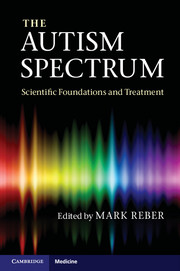Book contents
- Frontmatter
- Contents
- List of Abbreviations
- List of Contributors
- Preface
- Section 1 What We Know about Autism and How We Know It
- Section 2 Assessing and Treating Children with Autism Spectrum Disorders
- Chapter 7 Autism screening and diagnostic evaluation
- Chapter 8 Educational treatments for children with ASDs
- Chapter 9 Habilitative treatments for children with ASDs
- Chapter 10 Behavioral treatments for children with ASDs
- Chapter 11 Medication and nutritional treatments for children with ASDs
- Section 3 Assessing and Treating Adults with Autism Spectrum Disorders
- Index
- Plate Section
- References
Chapter 10 - Behavioral treatments for children with ASDs
from Section 2 - Assessing and Treating Children with Autism Spectrum Disorders
Published online by Cambridge University Press: 05 November 2012
- Frontmatter
- Contents
- List of Abbreviations
- List of Contributors
- Preface
- Section 1 What We Know about Autism and How We Know It
- Section 2 Assessing and Treating Children with Autism Spectrum Disorders
- Chapter 7 Autism screening and diagnostic evaluation
- Chapter 8 Educational treatments for children with ASDs
- Chapter 9 Habilitative treatments for children with ASDs
- Chapter 10 Behavioral treatments for children with ASDs
- Chapter 11 Medication and nutritional treatments for children with ASDs
- Section 3 Assessing and Treating Adults with Autism Spectrum Disorders
- Index
- Plate Section
- References
Summary
Behavioral treatments for Autism Spectrum Disorders (ASDs) are derived from learning theory, or more specifically, from B.F. Skinner’s work in the area of operant conditioning (Skinner, 1938). Under Skinner’s theoretical model, a behavior that is followed by what he called a reinforcer is more likely to recur. The basic premise of Skinner’s work was stated by Edward Thorndike in 1911, when he put forth in his Law of Effect that a behavior that leads to a positive or desired outcome will tend to be repeated. While it is not necessary to postulate the subjective experiences of positive or desired, Thorndike’s presentation of the lawfulness of behavior is illustrative. Future behavior is influenced by the outcomes of current behavior in a lawful, predictable manner. Learning theorists typically say that one may infer that learning has occurred from an observed change in behavior. Thus, lawful, predictable changes in behavior are thought to reflect learning. Spreat and Spreat (1982) noted that because learning occurs in a lawful manner, the question is never whether to use or not use the laws of learning to promote growth and change, but whether to use them in an effective and consistent manner.
A considerable body of literature exists regarding the application of operant conditioning and learning theory-based strategies both to teach new skills and to modify or eliminate undesirable behaviors. The reader is referred to a basic behavioral textbook, such as Richard Foxx’s Decreasing Behaviors of Severely Retarded and Autistic Persons (1982) or Repp and Singh’s (1990) review of aversive and non-aversive behavior modification strategies. This chapter will more specifically address behaviorally oriented treatment packages that are used to address behavioral symptoms of individuals with autism.
- Type
- Chapter
- Information
- The Autism SpectrumScientific Foundations and Treatment, pp. 239 - 257Publisher: Cambridge University PressPrint publication year: 2012



